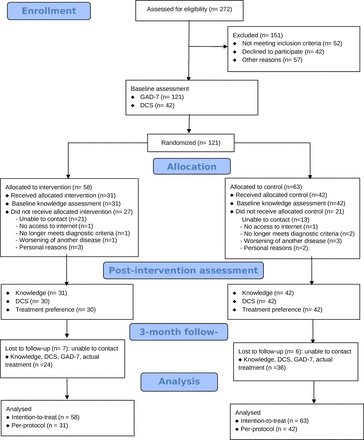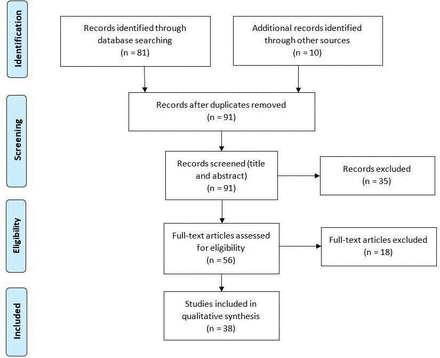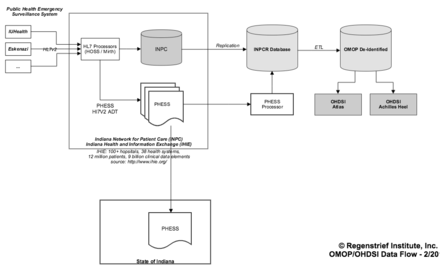Discussion
The intervention significantly improved patients’ knowledge about GAD and treatment options (50.9% relative between-group increase), a benefit that was maintained at 3 months. However, there was no significant effect on decisional conflict at both time points. The latest update of the Cochrane review on the effectiveness of PtDAs in any health condition showed strong evidence that PtDAs improve knowledge and decisional conflict related to feeling uninformed, among other variables of the SDM process.5 However, only 10 studies were focused on mental disorders, none of them on GAD.5 Three studies with patients with depression,18–20 and one including veterans with post-traumatic stress disorder,21 obtained significant reductions on decisional conflict, whereas one study with patients with bipolar II disorder and another on antidepressant use in pregnancy did not.22 23
One possible explanation for the absence of significance is methodological, given the high rate of patients who dropped out before the intervention or who had missed baseline values on the DCS, which could bias the results. A floor effect could also occur to some extent, since baseline scores for the whole sample showed a limited level of conflict (35 points, under the level of 37.5 considered meaningful24). A complementary explanation is based on the own psychological characteristics of patients with GAD, since its main symptom is a persistent and uncontrolled worry that could interfere with cognitive processes responsible for reducing uncertainty and decisional conflict. Compared with healthy controls, GAD patients show impaired reinforcement-based learning when making decisions involving potential rewards and punishments.3 They are less responsive to rewards25 and do not show an optimistic bias for positive events (the belief that they are more likely to happen to oneself than to others).26 These abnormal cognitive processes could act as a barrier to reduce decisional conflict, even when they have objectively improved their knowledge.
Alternatively, a delayed effect could be proposed based on the trend observed in the changes on the DCS; immediately at postintervention, scores were slightly worse in the intervention group, but at 3 months, there was a difference of 5 points favouring this group. Although this is a speculative explanation, it could be interesting to confirm whether this trend continues over time. Finally, the absence of effect could also be related to specific characteristics of our sample, or related to the covid pandemic context, as several studies have shown that it exacerbated anxiety symptoms and GAD rates.6 27
There was a low rate of quality decisions at 3 months, that is, based on good knowledge and concordant with the patient’s preference at post-intervention. The rate of concordant patients was very similar in both groups, around 36%. On one side, 54.5% of participants was being treated only with medication, but only 7.4% of the sample preferred that situation, indicating that many individuals would like to also receive psychotherapy. In Spain’s public health system, psychological services are scarce and waiting lists are long, and the follow-up was too short to identify enough individuals who had started psychotherapy. It is also possible that physicians do not refer patients to psychotherapy as frequently as patients want. On the other side, 21.5% of patients would prefer not to take medications (ie, receiving only psychotherapy), but only 4.1% of the sample exclusively received psychotherapy. This situation would also be reflecting a mismatch between patients and professionals’ preferences regarding treatment and its perceived outcomes.
In the PPS, there was a significant reduction of anxiety symptoms at 3 months (three points on the GAD-7), but in the ITT sample, the difference did not reach significance. A recent study with patients with chronic depression estimated a minimal clinically important difference of 4 points.28 Our aim in assessing anxiety at 3 months was just exploratory, since PtDAs are not aimed at improving health outcomes, but rather at guiding individuals in making decisions concordant with their informed preferences. However, some studies have obtained significant benefits on psychological or physical health outcomes.29 Future studies on GAD patients should clarify this issue.
The study has important limitations. First, the participation rate of eligible patients was only 55%, and therefore the sample could be representative only for those patients more motivated to participate. Regarding internal validity, the main limitation is the high dropout rate before the intervention and the high number of missing values in the primary variable. Due to the COVID pandemic, the intervention had to be implemented online, and 40% did not access the intervention or control websites. Although we used multiple imputation and ITT analyses, a risk of bias due to non-equivalence between groups remains. The only significant or near-significant predictor of losses was the education level, with more dropouts in less educated participants. This is itself a relevant result that warrants specific strategies to retain patients with lower education levels. Nonetheless, current empirical evidence on the effectiveness of retention strategies in RCTs is mostly of low quality6 30 and very scarce in the field of mental health. Another limitation refers to the assessment format, since the baseline and 3 month assessments were done by telephone, and the questionnaires used have not been validated on this format.
To the best of our knowledge, this is the first study that evaluates a PtDA for patients with GAD, and therefore comparisons with other samples are not possible. Future studies should clarify whether the observed absence of effect on patients’ decisional conflict is generalisable and due to the specific psychological characteristics of this population.





